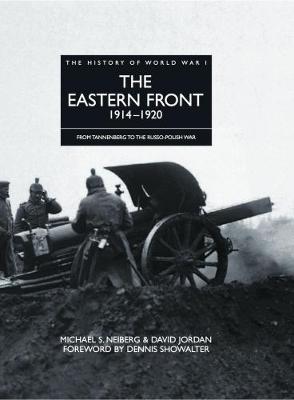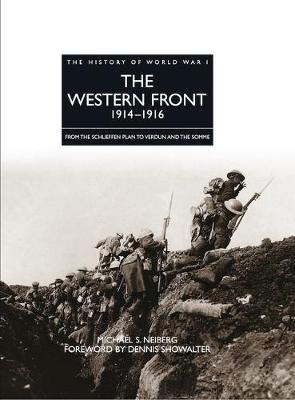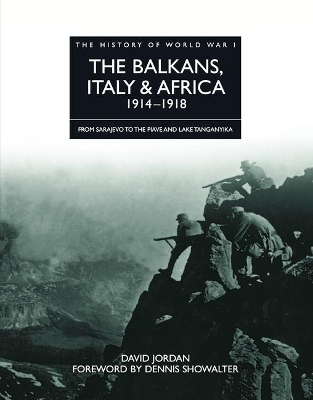The History of WWI
3 total works
The History of World War I series recounts the battles and campaigns of the 'Great War'. From the Falkland Islands to the lakes of Africa, across the Eastern and Western Fronts, to the former German colonies in the Pacific, the World War I series provides a six-volume history of the battles and campaigns that raged on land, at sea and in the air.
In 1914, the autocratic Russian Empire was allied to the democracies of France and Great Britain - and the small Kingdom of Serbia - through a series of treaties concluded in the late nineteenth and early twentieth centuries, and designed to counter the threat of the Central Powers of Germany and Austria-Hungary.
With the outbreak of war in August, the Russian forces mobilized and moved into the attack. Despite being outnumbered, the German commander, Paul von Hindenburg, destroyed one Russian army at the Battle of Tannenberg in August 1914, before defeating another at the Battle of the Masurian Lakes the following month. The Russians fared better against the Austro-Hungarian forces further south in Galicia, before reluctant German intervention to help their allies stabilized the situation.
The year 1915 saw the German High Command switch their main effort to the Eastern Front, resulting in the decisive German victory at Gorlice-Tarnow, and the subsequent capture of Warsaw and hundreds of square miles of formerly Russian-controlled territory.
The Russian Brusilov Offensive in the summer of 1916 and the Romanian entry into the war on the Allied side saw the latter's fortunes revive, but the success proved to be only temporary. Brusilov's attack stalled, while Romania was effectively knocked out of the war by a joint Central Powers offensive led by Germany and Bulgaria.
Increasing unrest in Russia culminated in the first revolution of 1917 and the abdication of Tsar Nicholas II. The offensives of the Russian Provisional Government failed, and a second revolution in November saw Lenin's Bolsheviks seize power. Having made peace with the Central Powers, the Bolsheviks fought the anti-Bolshevik 'White' Russian forces in the Civil War that followed, while a number of Allied powers sent forces to help the Whites. This conflict, combined with war with the newly-revived state of Poland in 1919, meant that large-scale fighting in Russia did not end until late 1920.
The length of the front in the East was much longer than in the West. The theatre of war was roughly delimited by the Baltic Sea in the West and Moscow in the East, a distance of 1,200 kilometres, and Saint Petersburg in the North and the Black Sea in the South, a distance of more than 1,600 kilometres. This had a drastic effect on the nature of the warfare. While World War I on the Western Front developed into trench warfare for much of the war, the battle lines on the Eastern Front were much more fluid, and trenches never truly developed.
The greater length of the front ensured that the density of soldiers in the line was lower so the line was easier to break. Once broken, the sparse communication networks made it difficult for the defender to rush reinforcements to the rupture in the line to mount a rapid counteroffensive and seal off a breakthrough. The terrain in the Eastern European theatre was quite solid, often making it near impossible to construct anything resembling the complicated trench systems on the Western Front, which tended to have muddier and much more workable terrain. In short, in the east the side defending did not have the overwhelming advantages it had on the Western Front. In fact the greatest advance of the whole war was made in the East by the German Army in the summer of 1915.
With the aid of over 300 black and white and colour photographs, complemented by full-colour maps, The Eastern Front provides a detailed guide to the background and conduct of the conflict on the Eastern Front, up to and including the Russian Civil War and the Russo-Polish War.
In 1914, the autocratic Russian Empire was allied to the democracies of France and Great Britain - and the small Kingdom of Serbia - through a series of treaties concluded in the late nineteenth and early twentieth centuries, and designed to counter the threat of the Central Powers of Germany and Austria-Hungary.
With the outbreak of war in August, the Russian forces mobilized and moved into the attack. Despite being outnumbered, the German commander, Paul von Hindenburg, destroyed one Russian army at the Battle of Tannenberg in August 1914, before defeating another at the Battle of the Masurian Lakes the following month. The Russians fared better against the Austro-Hungarian forces further south in Galicia, before reluctant German intervention to help their allies stabilized the situation.
The year 1915 saw the German High Command switch their main effort to the Eastern Front, resulting in the decisive German victory at Gorlice-Tarnow, and the subsequent capture of Warsaw and hundreds of square miles of formerly Russian-controlled territory.
The Russian Brusilov Offensive in the summer of 1916 and the Romanian entry into the war on the Allied side saw the latter's fortunes revive, but the success proved to be only temporary. Brusilov's attack stalled, while Romania was effectively knocked out of the war by a joint Central Powers offensive led by Germany and Bulgaria.
Increasing unrest in Russia culminated in the first revolution of 1917 and the abdication of Tsar Nicholas II. The offensives of the Russian Provisional Government failed, and a second revolution in November saw Lenin's Bolsheviks seize power. Having made peace with the Central Powers, the Bolsheviks fought the anti-Bolshevik 'White' Russian forces in the Civil War that followed, while a number of Allied powers sent forces to help the Whites. This conflict, combined with war with the newly-revived state of Poland in 1919, meant that large-scale fighting in Russia did not end until late 1920.
The length of the front in the East was much longer than in the West. The theatre of war was roughly delimited by the Baltic Sea in the West and Moscow in the East, a distance of 1,200 kilometres, and Saint Petersburg in the North and the Black Sea in the South, a distance of more than 1,600 kilometres. This had a drastic effect on the nature of the warfare. While World War I on the Western Front developed into trench warfare for much of the war, the battle lines on the Eastern Front were much more fluid, and trenches never truly developed.
The greater length of the front ensured that the density of soldiers in the line was lower so the line was easier to break. Once broken, the sparse communication networks made it difficult for the defender to rush reinforcements to the rupture in the line to mount a rapid counteroffensive and seal off a breakthrough. The terrain in the Eastern European theatre was quite solid, often making it near impossible to construct anything resembling the complicated trench systems on the Western Front, which tended to have muddier and much more workable terrain. In short, in the east the side defending did not have the overwhelming advantages it had on the Western Front. In fact the greatest advance of the whole war was made in the East by the German Army in the summer of 1915.
With the aid of over 300 black and white and colour photographs, complemented by full-colour maps, The Eastern Front provides a detailed guide to the background and conduct of the conflict on the Eastern Front, up to and including the Russian Civil War and the Russo-Polish War.
The Western Front, running from the Belgian coast in the north to the Swiss border in the south, was to prove the decisive battlefront of World War I. It was where the great powers of Germany, France and the British Empire concentrated the bulk of their military might, and it was where many believed the war would be settled before Christmas 1914.
The German General Staff realised the dangers of fighting a two-front war against both France and Russia simultaneously. They sought to knock the French out of the war quickly, making a rapid advance on Paris through neutral Belgium - the infamous 'Schlieffen Plan'.
After desperate delaying actions fought by the French and British armies, the German hope for swift victory in the West was thwarted by their defeat at the First Battle of the Marne. Following a 'Race to the Sea' - where each side sought to outflank the other, culminating in the battles of First Ypres and the Yser - the Western Front settled down into a pattern of trench warfare that would remain little changed until 1917.
The year 1915 proved one of frustration for the Allies as attack after attack - in Champagne, at Neuve Chapelle, Festubert and Loos - all failed to pierce the German defensive lines. To break the deadlock, a joint Allied offensive was planned for 1916 with simultaneous attacks against the Central Powers to take place in all the European theatres.
This planned major effort was pre-empted by the German assault on the fortress city of Verdun, intended to bleed the French Army dry. The joint Somme offensive thus became a largely British and Imperial affair to relieve the pressure on their French allies. The blooding of Kitchener's volunteer New Army on the first day of the Somme has become a byword for the slaughter on the Western Front. By the year's end, it was clear there would be no easy victory for either side.
With the aid of over 300 photographs, complemented by full-colour maps, The Western Front 1914-1916 provides a detailed guide to the background and conduct of the conflict on the Western Front in the first half of the war, up to and including the Battles of the Somme and Verdun.
The German General Staff realised the dangers of fighting a two-front war against both France and Russia simultaneously. They sought to knock the French out of the war quickly, making a rapid advance on Paris through neutral Belgium - the infamous 'Schlieffen Plan'.
After desperate delaying actions fought by the French and British armies, the German hope for swift victory in the West was thwarted by their defeat at the First Battle of the Marne. Following a 'Race to the Sea' - where each side sought to outflank the other, culminating in the battles of First Ypres and the Yser - the Western Front settled down into a pattern of trench warfare that would remain little changed until 1917.
The year 1915 proved one of frustration for the Allies as attack after attack - in Champagne, at Neuve Chapelle, Festubert and Loos - all failed to pierce the German defensive lines. To break the deadlock, a joint Allied offensive was planned for 1916 with simultaneous attacks against the Central Powers to take place in all the European theatres.
This planned major effort was pre-empted by the German assault on the fortress city of Verdun, intended to bleed the French Army dry. The joint Somme offensive thus became a largely British and Imperial affair to relieve the pressure on their French allies. The blooding of Kitchener's volunteer New Army on the first day of the Somme has become a byword for the slaughter on the Western Front. By the year's end, it was clear there would be no easy victory for either side.
With the aid of over 300 photographs, complemented by full-colour maps, The Western Front 1914-1916 provides a detailed guide to the background and conduct of the conflict on the Western Front in the first half of the war, up to and including the Battles of the Somme and Verdun.
The History of World War I series recounts the battles and campaigns that took place during the 'Great War'. From the Falkland Islands to the lakes of Africa, across the Eastern and Western Fronts, to the former German colonies in the Pacific, the series provides a six-volume history of the battles and campaigns on land, at sea and in the air.
The assassination in Sarajevo of the Austro-Hungarian heir, Archduke Franz Ferdinand lit an explosive mixture of ethnic tensions, nationalism, political opportunism, and the quest for power within the Balkans to plunge Europe into a conflict that would cost millions of lives. Austro-Hungary faced both Serbia and Russia during the opening phase of the war, but Bulgaria's decision to join the Central Powers in October 1915 led to the opening of the Salonika front in Greece, where 150,0000 British and French troops saw little fighting until the disastrous 1918 Doiran campaign.
At the war's outbreak, the British authorities in Africa were totally unprepared, with few forces available to attack the German colonies, who themselves were effectively left isolated from help. The German commander in East Africa, Paul von Lettow-Vorbeck, launched a brilliant guerrilla campaign with scant resources, conducting lightning attacks on Allied targets, particularly the Uganda Railway. He was opposed by the South African General Jan Smuts and his mixture of Boer, British, Rhodesian, Indian, African, Belgian and Portuguese soldiers: fighting continued until November 1918.
Italy entered the war against the Central Powers in April 1915. For two years, Austro-Hungarian forces were kept at bay on Italy's northern borders, until a combined German and Austro-Hungarian defeated the Italian forces at the Battle of Caporetto in October 1917. Revenge came with the Allied victory at Vittorio Veneto in November 1918, which led to Austro-Hungary's collapse.
With the aid of over 300 photographs, complemented by full-colour maps, The Balkans, Italy & Africa provides a detailed guide to the background and conduct of the war in the Balkan, Italian and African theatres from the assassination in Sarajevo to the surrender of the Central Powers.
The assassination in Sarajevo of the Austro-Hungarian heir, Archduke Franz Ferdinand lit an explosive mixture of ethnic tensions, nationalism, political opportunism, and the quest for power within the Balkans to plunge Europe into a conflict that would cost millions of lives. Austro-Hungary faced both Serbia and Russia during the opening phase of the war, but Bulgaria's decision to join the Central Powers in October 1915 led to the opening of the Salonika front in Greece, where 150,0000 British and French troops saw little fighting until the disastrous 1918 Doiran campaign.
At the war's outbreak, the British authorities in Africa were totally unprepared, with few forces available to attack the German colonies, who themselves were effectively left isolated from help. The German commander in East Africa, Paul von Lettow-Vorbeck, launched a brilliant guerrilla campaign with scant resources, conducting lightning attacks on Allied targets, particularly the Uganda Railway. He was opposed by the South African General Jan Smuts and his mixture of Boer, British, Rhodesian, Indian, African, Belgian and Portuguese soldiers: fighting continued until November 1918.
Italy entered the war against the Central Powers in April 1915. For two years, Austro-Hungarian forces were kept at bay on Italy's northern borders, until a combined German and Austro-Hungarian defeated the Italian forces at the Battle of Caporetto in October 1917. Revenge came with the Allied victory at Vittorio Veneto in November 1918, which led to Austro-Hungary's collapse.
With the aid of over 300 photographs, complemented by full-colour maps, The Balkans, Italy & Africa provides a detailed guide to the background and conduct of the war in the Balkan, Italian and African theatres from the assassination in Sarajevo to the surrender of the Central Powers.


